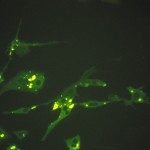Link to Pubmed [PMID] – 10364307
J. Virol. 1999 Jul;73(7):5586-92
A novel hantavirus, first detected in Siberian lemmings (Lemmus sibiricus) collected near the Topografov River in the Taymyr Peninsula, Siberia (A. Plyusnin et al., Lancet 347:1835-1836, 1996), was isolated in Vero E6 cells and in laboratory-bred Norwegian lemmings (Lemmus lemmus). The virus, named Topografov virus (TOP), was most closely related to Khabarovsk virus (KBR) and Puumala viruses (PUU). In a cross focus reduction neutralization test, anti-TOP Lemmus antisera showed titers at least fourfold higher with TOP than with other hantaviruses; however, a rabbit anti-KBR antiserum neutralized TOP and KBR at the same titer. The TOP M segment showed 77% nucleotide and 88% amino acid identity with KBR and 76% nucleotide and 82% amino acid identity with PUU. However, the homology between TOP and the KBR S segment was disproportionately higher: 88% at the nucleotide level and 96% at the amino acid level. The 3′ noncoding regions of KBR and the TOP S and M segments were alignable except for 113- and 58-nucleotide deletions in KBR. The phylogenetic relationships of TOP, KBR, and PUU and their respective rodent carriers suggest that an exceptional host switch took place during the evolution of these viruses; while TOP and KBR are monophyletic, the respective rodent host species are only distantly related.

